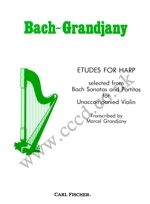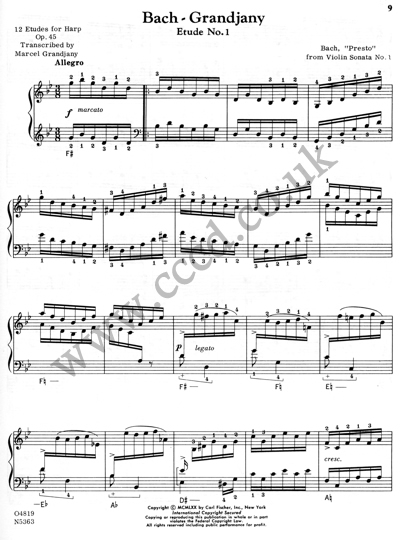 |
Etudes
for Harp JS Bach Transcribed Marcel Grandjany |
|
| Contents: | 12 Studies | |
| Instrumentation: | Pedal Harp | |
| Level: | Intermediate/Advanced Grade 6 -8 | |
| Format: | 230 x 305mm Stapled Score | |
| ISMN: | 0-8258-0328-4 | |
| Publisher: | Carl Fischer | |
| Edition/Year: | 1970 | |
| Origin: | USA | |
| Our Ref: | UM0011 | |
| Buy this music now £23.95 +p&p | ||
| Other music by JS Bach | ||
CONTENTS
Etude 1 Bach, “Presto” From
Violin Sonata #1
Etude 2 Bach, “Fugue” From
Violin Sonata #1
Etude 3 Bach, “S arabande” From
Violin Partita #1
Etude 4 Bach, “Sarabande’s
Double” From
Violin Partita #1
Etude 5 Bach, “Corrente’s
Double” (Variation)
from Violin Partita #1
Etude 6 Bach, “Andante” From
Violin Sonata #2
Etude 7 Bach, “Allemande” From
Violin Partita #2
Etude 8 Bach, “Bourree” From
Violin Partita #1
Etude 9 Bach, “Bourree’s
Double” From
Violin Partita #1
Etude 10 Bach, “Giga”
From Violin Partita #2
Etude 11 Bach, “Allegro
Assai” From Violin Sonata #3
Etude 12 Bach, “Prelude” From Violin Partita
#3
Bach’s six works for unaccompanied violin belong to two clearly differentiated categories. Three of them were designated by the composer himself as “Sonatas,” the others as “Partitas.”
The Sonatas show uniformity in their construction through the various movement and key relationships.
It is significant that Bach subsequently transcribed most of the movements of these Sonatas for keyboard instruments, thus testifying to the implied polyphony of these violin pieces by transforming them into exquisite compositions for the organ or harpsichord. One notable example is the Fugue from Sonata No. 1 in G Minor (Etude #2 for Harp) which exists also as the Fugue in D Minor for Organ.
The term “Partita” had two different meanings in the composer’s time. It designated a Suite of Dances or a set of Variations. Bach wrote works of both types:
Partitas for organ consisting of Variations on a chorale melody, and Partitas for harpsichord comprising sets of Dances. In the violin Partitas he aimed at combining both of these aspects, writing sets of Dances which in many respects resemble those for clavier while on the other hand allowing ample space to variation treatment.
A “Double:’ found in Partitas, is actually a Variation which follows one or more of the dance movements. The so-called “Double” dissolves the harmonic structure of the preceding Dance into fast-moving melodic lines.